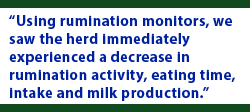
Challenges of feeding late-season alfalfa
 By Stacy Nichols, Vita Plus dairy technical specialist
By Stacy Nichols, Vita Plus dairy technical specialist
It’s not unusual for dairy consultants to be asked about harvesting alfalfa after a freeze or frost in the fall. This forage is often harvested because it can provide a significant yield to boost forage inventories, and it is assumed the alfalfa has gone dormant, meaning little harm will be done to the plant. Furthermore, traditional forage tests often show this late-season, immature alfalfa is very high quality with high crude protein levels (greater than 23%) and low fiber content (aNDFom less than 32%) resulting in a very high relative forage quality (RFQ). Thus, harvesting alfalfa after a frost seems like a great idea.
Despite these benefits, this alfalfa rarely feeds well. Vita Plus nutritionists troubleshoot several calls each year about lower-than-anticipated milk production when this late-season alfalfa is being fed. Last fall, I worked with a herd that fed a fourth cutting of alfalfa with fiber levels less than 30% and an RFQ greater than 215.  Using rumination monitors, we saw the herd immediately experienced a decrease in rumination activity, eating time, intake and milk production. Once we reduced the feeding rate of that alfalfa, the negative effects became more moderate before we ultimately eliminated it from the ration entirely.
Using rumination monitors, we saw the herd immediately experienced a decrease in rumination activity, eating time, intake and milk production. Once we reduced the feeding rate of that alfalfa, the negative effects became more moderate before we ultimately eliminated it from the ration entirely.
Unfortunately, this aspect of dairy nutrition has little research, but we can offer some theories about why it may not feed as well as we would expect:
- Lower digestible fiber
Even though this late-season, immature alfalfa may have a high RFQ, it often has a lower concentration of digestible fiber than other cuttings of alfalfa and provides fewer calories to the cow. - Harvest conditions
It is often cold when this forage is harvested, which results in minimal, if any, microbial activity to promote fermentation. It is also speculated that freezing conditions can rupture plant cells and lose cellular contents that are normally readily available nutrients for the cow. - Dormancy compounds in alfalfa
When alfalfa goes dormant, it accumulates long chain sugars and increases a few specific amino acids. These compounds act as an “antifreeze” to allow the alfalfa plant to survive winter. We know these compounds accumulate in the root system, but we don’t know the concentration of these compounds in the stems and leaves of dormant alfalfa or if they are antinutritional to dairy cows. - Saponins
Saponins are a group of compounds that cause a foam/slime layer to form in the rumen. This foam/slime layer is a key cause of bloat in animals that graze lush alfalfa. Saponins decrease intakes because they have a bitter taste. Some of the compounds can irritate animal tissues and some inhibit rumen microbial production, which leads to decreases in feed digestion in the rumen, microbial protein production, and intake. Some evidence also shows saponins decrease ruminal contractions. The potential combination of these effects might explain the poor performance of cows being fed late-season, immature alfalfa.Some alfalfa varieties have higher levels of saponins than others. Immature alfalfa has a higher saponin concentration, which could be the reason we don’t see these challenges in our spring and summer cuttings that are harvested in the bud or bloom stage.
It’s important to understand the risks before you decide to take that additional cutting of alfalfa because the challenges associated with it are not often worth the extra forage. Talk with your Vita Plus consultant to learn more about the challenges associated with feeding this late-season, immature alfalfa.
| Category: |
Feed quality and nutrition Forage Foundations Forage harvesting |

